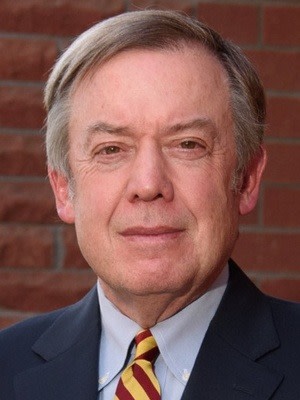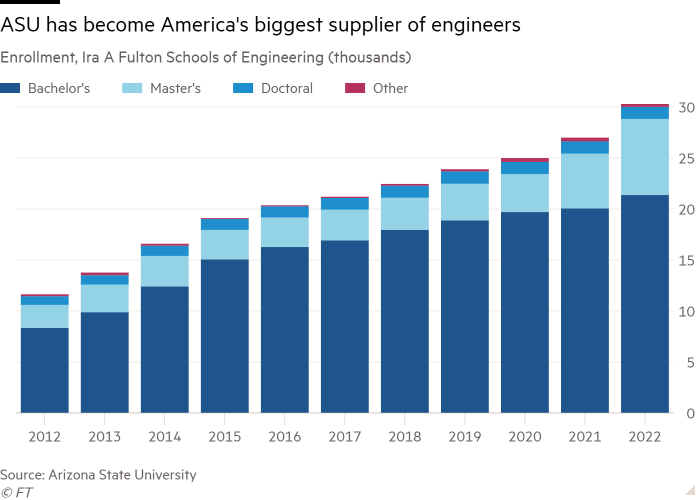‘Our secret weapon’: how a university bolstered Phoenix’s rise as US chip capital

Roula Khalaf, Editor of the FT, selects her favourite stories in this weekly newsletter.
At the turn of the millennium, Phoenix’s economy was dominated by the tourism and real estate industries that are the natural byproduct of year-round sun.
The region’s largest university reflected that influence. Arizona State had earned a reputation as a “party school” where students paid more attention to their tans and a highly-ranked football team than academics.
The sun-drenched campus in the Phoenix suburb of Tempe has not fully lost its image as a place for outdoor fun. But inside ASU’s modernist buildings, a transformation has taken place.
Today it is a microelectronics Petri dish — a hive of research and development for the semiconductor industry — while also establishing itself as America’s leading conveyor belt of engineers. All of this has laid the groundwork for the “Valley of the Sun” as the beating heart of the country’s chipmaking boom.
“We were a 20th-century university and we needed to be a 21st-century university laying down the tracks for a 22nd-century economy,” says Michael Crow, the president of ASU who is widely credited for the university’s transformation.

“The world that we’re building is not the world we are coming out of. Microchips are now going to be the rough equivalency of electricity — or water.”
The university has become one of the most important engines for a city that some have described as the new US semiconductor capital. The shift has come amid a scramble in Washington to rebuild domestic capacity to manufacture semiconductors, offering billions of dollars of incentives for companies to build fabrication plants (“fabs”).
ASU’s engineering school now boasts 24,000 on-campus students — more than any other standalone university in the country — and has plans to expand that number to 30,000 within the next three years. Another 8,000 study via the internet after it introduced America’s first fully-accredited online degrees in electrical, software and mechanical engineering.

Even though the dry climate and isolation from natural disasters helped Phoenix become part of the semiconductor business decades ago — starting with Motorola in the immediate postwar period — government leaders give the university credit for helping launch a chip renaissance in the region.
“I would say our secret weapon in all of this has been Arizona State University,” says Kate Gallego, Phoenix’s mayor. “They have helped us attract foreign investment because they can provide the very top tier graduates to staff these companies.”
Capital has poured in. More than $60bn of investments have been announced in Maricopa County — in which Phoenix sits — since 2020, according to data from fDi Markets. Put another way: of the $242bn that has been invested in American chipmaking in the past two decades, more than a quarter of that has flowed into Maricopa County in just the past four years.
Three years ago, with the help of ASU and Crow, Phoenix bagged its biggest prize: TSMC, the world’s largest maker of high-end semiconductors. The Taiwanese company announced a $12bn investment to build a fab to the city’s north in 2020. Last December, the company increased its commitment to $40bn.
ASU’s role in the revitalisation reflects a wider economic development trend nationwide. In the global battle for high-tech funding, research universities are now being deployed to the front lines, helping US cities attract the biggest capital investments with the promise of a skilled workforce that has become central to the ability of tech groups to expand.
“What we’re starting to see now is a realisation that American research universities can play a much wider role across the country in spurring economic development at the local level,” says Ross DeVol, president of think-tank Heartland Forward.
In Pittsburgh, Carnegie Mellon University has helped transform a city once known for its rusting steel industry into a robotics and AI hub. Cleveland has been reinvigorated, in part, by Case Western Reserve University.
In some ways, those municipalities are following the model established a half-century ago by Stanford University, where research and innovation were instrumental to the creation of Silicon Valley. But, unlike California in the 1970s, the most important role now played by ASU and similar engineering schools has been creating a skilled workforce amid one of the tightest job markets in generations.
Phoenix had the advantage of its legacy semiconductor manufacturers to help build on when Crow took the helm of ASU. Intel has had a presence in the region for more than four decades and is now expanding significantly — pumping $20bn into two new fabs in Chandler, in Phoenix’s south-east.
But the region’s arrival as a chipmaking superpower has been cemented by TSMC. In the city’s north-west, its burgeoning plants are rapidly growing out of a plot of land larger than New York City’s Central Park.
Cranes loom over skeletal structures that will house some of the most advanced semiconductor operations anywhere in the world. Just months ago, the parcel was little more than scrubland.
The pace of this change — turbocharged by the $52bn of subsidy provided by the Chips and Science Act passed last year — and the demands it has placed on the city, have brought with it their own challenges.
TSMC has blamed labour shortages for a decision to delay the opening of its first plant from next year to 2025. It is parachuting in more than 500 workers from Taiwan to plug the gap — much to the dismay of local unions. Cultural clashes have also raised concerns locally.
“We are encountering certain challenges as there is an insufficient amount of skilled workers with the specialised expertise required for equipment installation in a semiconductor-grade facility,” TSMC chair Mark Liu told investors in July.
That has piled pressure on the city’s leaders to accelerate a transformation of the local labour force.
“If you suddenly grow a lot of companies . . . the number one problem is the talent pool,” says Satheesh Kuppurao, vice-president for business development and growth at Applied Materials, which supplies technology and equipment to chipmakers — and has already seen annual revenues nearly double in the past six years to $26bn.
“For the longest time people have thought: ‘Hey, manufacturing always went out of the US. Why is this a good career for me?’” he adds. “We’re fighting against those historical things. We need to turn the tide to attract enough students to the industry.”
ASU is collaborating with chipmakers by adapting curriculums, developing new research initiatives and further expanding its engineering department.
FT Live event: Investing in America Summit

7 November 2023
Can foreign multinationals continue to find opportunity in the US?
In-Person & Digital | Miami, PAMM | #FTInvestinginAmerica
“There’s heavy, heavy, heavy pushing for advanced training, workforce development,” says Crow. “It’s all moving quickly, but I think TSMC would like it to move even quicker.”
TSMC declined to be interviewed but said in a statement that it was “confident that the strength and diversity of the engineering talent pipeline from colleges and universities across the US will provide us with outstanding recruits”.
On campus, the effort to grab graduate talent is evident. “The career fair is like a zoo,” says Gabriel Adams, a 20-year-old electrical engineering student at ASU from nearby Gilbert. “Jobs in general are, I think, at the front of a lot of people’s minds.”
And it is not just engineers that Phoenix is producing en masse. In the city’s colleges, courses are being offered to help lower-skilled workers secure jobs as semiconductor technicians.
“I’m watching our society change — and people need educated workers faster than they can get educated,” says Tammy Robinson, president of Mesa Community College. Along with two other local colleges, Mesa has introduced a two-week crash course for workers to retrain as semiconductor technicians.
Dubbed Quick Start — and developed in conjunction with Intel — the programme aims to churn out industry-ready employees after working their way through a rapid-fire 10-day training course.
“This is a way to get them through the front door — and get them through quickly,” says Robinson. “None of us can afford to be passive anymore.”
Additional reporting by Amanda Chu in New York



Comments